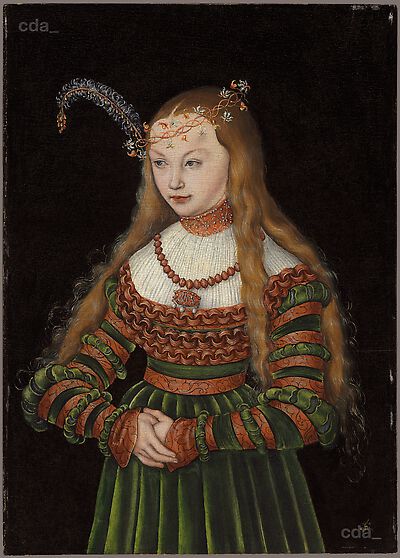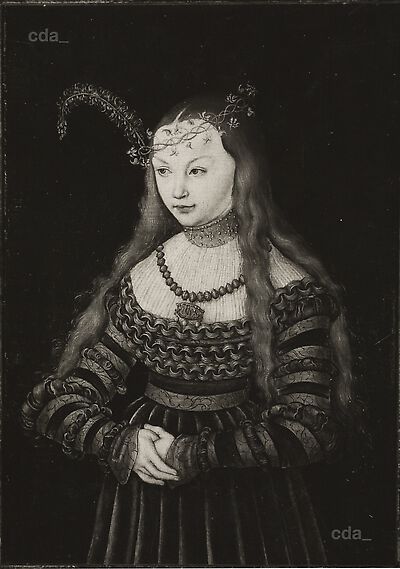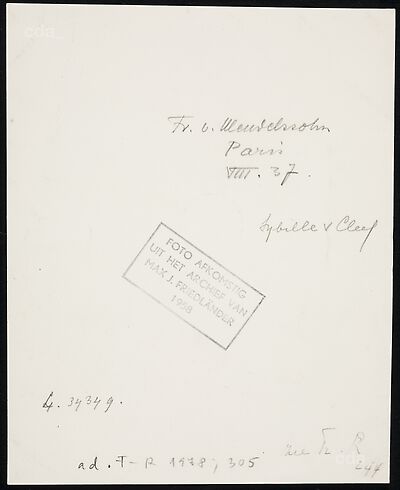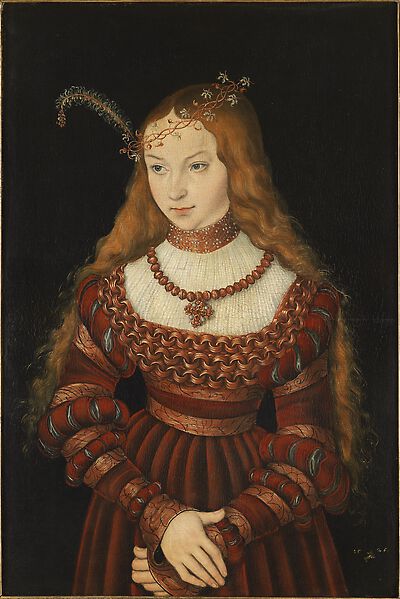This portrait of Princess Sybille of Cleves (1512-1554) was painted when she was fourteen years old and newly betrothed to Johann Friedrich I (1503-1554), the future Elector of Saxony. The oldest daughter of Johann III, Duke of Cleves, and Maria of Jülich-Berg, Sybille grew up at court in Düsseldorf with her sister Anne, one of the future wives of Henry VIII. Her marriage into the House of Saxony placed Sybille in the middle of the greatest ideological struggle of the sixteenth century, a reformation not only of the church but also of the state. A committed friend and supporter of Martin Luther, Johann Friedrich was actively engaged in the Reformation and took dramatic political and military risks to protect the reformatory movement. Sybille conducted a correspondence of her own with Martin Luther and actively supported her husband's many campaigns, defending Wittenberg in his absence during Emperor Charles V's siege of the city in 1546.
This portrait of Sybille was painted sometime after her betrothal to Johann Friedrich in September 1526 and before their marriage on 3 June 1527. Emperor Charles V and Johann Friedrich's uncle, the Elector Friedrich III (called the Wise), had arranged a marriage between the future Elector and the Emperor's youngest sister Katharina in 1521. With no wedding having materialized by February 1524 and the marriage of Katharina to her cousin, King John III of Portugal, taking place in February 1525, the Elector began searching for another bride for his nephew. Johann Friedrich's betrothal to Sybille of Cleves took place at Burg on the Wupper on 8 September 1526 and the wedding ceremony followed on 3 June 1527 at Torgau. Lucas Cranach provided the lavish decorations.
The jeweled and feathered wreath, the object most associated with the bride in sixteenth-century Germany, is the most obvious indication that this portrait was painted after Sybille's betrothal in September 1526. The wreath was linked symbolically to the bride's virginity, and she presented it to the groom at the engagement and wedding ceremonies as both a testament to and an offering of her virtue. The procession to the church was an important part of the wedding ceremony on all societal levels and at this time the bride would wear her hair loose or uncovered apart from the wreath, as Sybille appears here. In her procession into Saxony, Sybille was accompanied by two hundred horses ridden by the nobility of Jülich and Cleves.
Apart from the wreath, symbols of her betrothal to Johann Friedrich are literally woven into the fabric of Sybille's dress. The House of Saxony is symbolized by the pattern in the gold fabric of her sleeves and around her waist and the three large interconnected chains around her chest. The pendant hanging from her neck announces the joining of the two families and suggests that this portrait was commissioned by her father. The letters on the pendant, 'i/j b c s', indicate both her lineage and the family she is soon to join - her father's full title was Duke of Iülich/Jülich, Berg and Cleves, and the dynasty she is joining is that of Saxony.
A second betrothal portrait of Sybille of Cleves by Cranach appears together with a pendant of Johann Friedrich in Weimar. Both panels, signed with the artist's mark and dated 1526, are taller and slightly narrower than the present portrait. Sybille wears the same dress with the Saxon pattern woven into the gold fabric and the three large chains around her chest. Her hair is similarly worn down and the wedding wreath likewise sits at an angle on her head. Subtle changes in her pose and appearance, however, suggest a slightly different moment and, perhaps, the passage of time. The Weimar painting shows Sybille in a similar three-quarter-length pose against a dark background and her hands, rather than clasping one another at her waist, are held one over the other in a slightly lower position. Her hair has been pulled behind her shoulders and her face has taken on a more mature aspect. Her features and bone structure are more defined and her gaze appears to be more purposeful as she looks in the direction of her husband. Two changes in Sybille's dress are significant: her dress is red, the color of the dynasty of Cleves, and the pendant bearing her father's initials has been replaced with a jeweled cross.
While Friedländer dated the present painting to 1525 largely due to the sitter's more youthful appearance, the details of Sybille's dress confirm that both this portrait and the Weimar pendant were painted during her nine-month betrothal to Johann Friedrich. Every aspect of these portraits, from the fabrics and jewels to her hair and her pose, had some significance to the contemporary viewer and while not all of the iconography is decipherable today, the differences between the Weimar painting and the present portrait may explain something about the circumstances in which they were created. As a pendant, the Weimar portrait served as a visual record of the formal joining of the houses of Saxony and Cleves. As with the divisions of a coat of arms, she represented her family by wearing the colors of her dynasty but the replacement of the more personal pendant bearing her father's initials may be an acknowledgment of the necessary shift of her loyalties from her own family to that of her husband.
No pendant to our portrait is known and the green fabric of Sybille's dress has no connection with either house. It could have been a color that she particularly liked or carried some general association, as in previous centuries, with hope. There is no question that the pendant in this painting emphasizes her own lineage and it is possible that this portrait was made for Sybille's family in Cleves while the one in Weimar was an official portrait documenting the match. Cranach's linear style and his abstract sense of volume indicated by the concentric bands around Sybille's chest and arms lends itself to the use of the portrait medium as a way of signaling status. In court portraiture of this period the signaling of status was the goal. [...]
[http://www.christies.com/LotFinder/lot_details.aspx?intObjectID=5056178; 24.02.2014]




